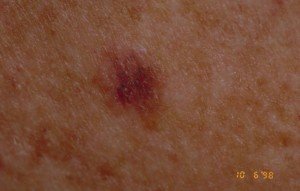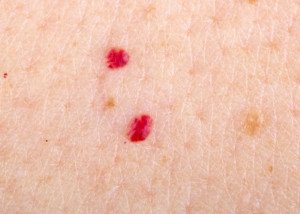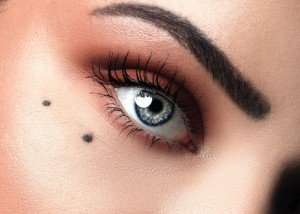Here is information about red melanomas vs. benign red moles in terms of physical appearance.
“Benign moles can appear reddish in part due to sunburn or irritation,” says Dr. Michael Shapiro, MD, Medical Director and Founder of Vanguard Dermatology in NYC, NY.
Dr. Shapiro continues, “Repeated sunburn to moles will increase the risk of the mole turning cancerous, so use caution when going outside.
“Irritation can make moles red due to chaffing, which won’t directly increase the risk of melanoma, but it’s important to use caution, as it may cause the mole to be more sensitive, increasing its susceptibility to cancer.”
Melanoma vs. Benign Mole
“For most professional, experienced dermatologists, it is fairly simple to define a melanoma spot from a benign,” says Dr. Shapiro.
“However, there are ways to help the average patient to understand the difference from a red melanoma from a red benign spot such as angiomas.”
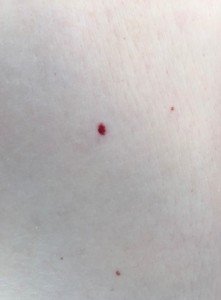
Angiomas
Angiomas (“strawberry marks,” hemangiomas) are concentrations of very tiny blood vessels and appear as red dots or moles on the skin.
They increase with age and can be elevated and quite striking in their strawberry/red color.
“A malignant spot will differ from a benign mole, in that it will have different variations of the color red or any other color that is not consistent throughout,” explains Dr. Shapiro.
“A malignant mole will also be asymmetrical and bumpy as opposed to a benign mole being symmetrical and fairly smooth throughout.
“While these are some tips to help assist you in self-diagnosis, if you are unsure in any way seek out professional medical attention. Request a biopsy.”
The image at the top of this post is of a melanoma.
Other Red Spots on the Skin
Dr. Shapiro further explains, “There are several different kinds of red or dark pink or magenta benign spots that may also appear on the skin.
“Dermatofibromas are small, firm, typically red bumps caused by an increase of fibroblasts or soft tissue cells under the skin.
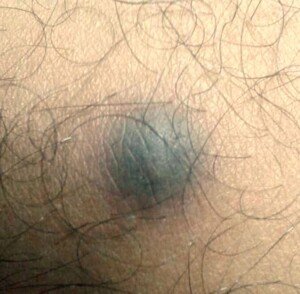
Dermatofibroma. Mohammad2018 CC BY-SA
“They are usually itchy and found on the legs and can be removed through surgery if the pain becomes a severe problem.
“Pyogenic granulomas can also appear on the skin — not to be confused with malignant moles — these are caused by excessive growth of small blood vessels and swelling.
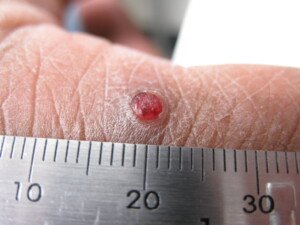
Pyogenic granuloma. Kilbad at English Wikipedia, CC BY
“These are common after an injury to the skin and usually disappear without any treatment.”
If a brown, tan or beige mole starts developing a red portion, immediately see a dermatologist, as this may be a sign of melanoma; a biopsy will rule it in or out.
Keep track of your moles with monthly skin self-exams so that you know which ones are normally red, tan, brown, etc.
 Dr. Shapiro is a board certified dermatologist and Mohs surgeon and has treated over 12,000 Mohs cases for skin cancer. He is widely published in peer-reviewed academic journals.
Dr. Shapiro is a board certified dermatologist and Mohs surgeon and has treated over 12,000 Mohs cases for skin cancer. He is widely published in peer-reviewed academic journals.
 Lorra Garrick has been covering medical, fitness and cybersecurity topics for many years, having written thousands of articles for print magazines and websites, including as a ghostwriter. She’s also a former ACE-certified personal trainer.
Lorra Garrick has been covering medical, fitness and cybersecurity topics for many years, having written thousands of articles for print magazines and websites, including as a ghostwriter. She’s also a former ACE-certified personal trainer.

